Cuba: Riding ‘Round The Rules
Cuba is bigger than you might think. You’ll likely use all three months of your visa if you ride the whole island. And I recommend you do because Cuba is like no other country in Latin America – or the world for that matter. But the Cuba you’ll experience as a bicycle traveller isn’t the Cuba most visitors see.
Contrary to popular belief, Cuba is not a place of loud street parties, musicians on every corner, and noisy political rallies. Cuba is mostly a quiet place, even in the towns. That splashy, in-your-face Cuba of tourist and news propaganda represents a very limited view.
You’ll spend most of your days pedalling to the sounds of sugar cane shuffling in the wind, or waves breaking on a pebbly beach, or the occasional whistle of a campesino communicating with beasts of burden in a nearby field. In the towns, the noisiest feature is usually children in schoolyards playing and screaming (recess seems to be an all-day event in Cuba). Often, I’d arrive in towns where everyone seemed to be simply sitting around, not working, not really doing anything; at most, there might be a domino game going on in the park.
Another common misconception is that Cuba is expensive. Around the holiday resorts in Varadero and at tourist sites in Havana, Viñales, and elsewhere, this may be true. But out in the real Cuba, the Cuba where most Cubans live (and where you’ll be cycling), it’s easily the least expensive country to bike tour in Latin America.
Cuba uses two currencies, the Convertible Peso (CUC, also called divisa, and used mostly by tourists) and the Cuban Peso (CUP, also called moneda nacional, and used mostly by Cubans); you’ll be using the latter, not that you’ll have much to spend your money on.
Even when you do find a little bakery or somewhere to buy staple foods, you’ll be told that, as a foreigner, you cannot purchase anything and that everything is “bought” with ration booklets (or por cuota, as they say in Cuba). But as they also say in Cuba, “en Cuba se resuelve todo” (in Cuba there’s always a way), and if you’re patient, it’s fairly easy to bribe the worker behind the counter to “sell” you some food for a few CUPs when nobody’s looking.
If you’re a shy person who always follows the rules, you’ll find Cuba a difficult place to tour.
In rural Cuba you’ll have to knock on doors to find food if you don’t want to starve. Any private house in the campo is a potential restaurant. Simply knock on the door, explain that you’re travelling by bicycle, and that you’d like to buy some food. The occupants won’t think this is strange; they understand the system and why you’re hungry. I did this all over the country and I always ate my fill for under five dollars. You’ll often be invited to sit down with the family for a cooked meal (usually rice and beans, perhaps with tomatoes, eggs, or pork). It’s also a great way to meet people and learn about the local area.
Cuba has a kind of institutionalized bed-and-breakfast system whereby rooms in certain private homes (casas particulares) have been turned into guest rooms (look for the green or blue arrendador inscripto sign on the door). I have a couple of thoughts on this. First, not all casas are for tourists; some are for Cubans only (red sign). Second, there are two kinds of casas: the official, government-endorsed casas where you’ll have to surrender your passport and follow the rules; and the unofficial, illegal, easy-going casas which are just as good but do not advertise themselves (for obvious reasons). Guess which are cheaper.
The best accommodation for cyclists in Cuba is camping – the whole country is like one big camp ground. I’ve camped in forests, next to rivers, in farmer’s fields, on deserted beaches, in mango plantations, grapefruit and orange groves, and behind people’s houses. It’s free, it’s fun, and there’s always somewhere to pitch a tent. But be sure to study the ground before you peg down because the ants are a bit of a nuisance in some areas.
The hills can be very steep in Cuba and the headwinds very strong in some areas. Traffic is not an issue for cyclists as there are relatively few vehicles on the road. Cyclists will experience more freedom in Cuba than any other type of traveller.
Cuba is a rewarding country to cycle; often beautiful, sometimes frustrating, always interesting – an unforgettable place that will change the way you think of Latin America and Latin Americans.
ALSO ON CUBA:
Evasive Cycling Maneuvers In Cuba How to dodge a Cuban toll gate with out getting caught!
Bike Shops: What’s Not At The Bicicletería When you land in Cuba with a smashed derailleur, how do you find a replacement in a country with no stuff?
Sometimes, You Gotta Push Cuba’s Sierra del Escambray has some of the steepest hills in Latin America.
Official Name: La República de Cuba
Area: 110,860 km² (42,803 sq. mi.)
Population: 12 million
Capital: La Habana
National Official Language: Spanish
Other Languages: Lucumi (African origin, used in Santería rituals)
Currency: peso cubano (CUP), peso convertible (CUC)
Highest point: Pico Turquino 1,975 m (6,480 ft.)
Lowest point: Caribbean Sea 0 m
Feature image (top of page): A hurricane-damaged coast in the north.
© El Pedalero, 2012.
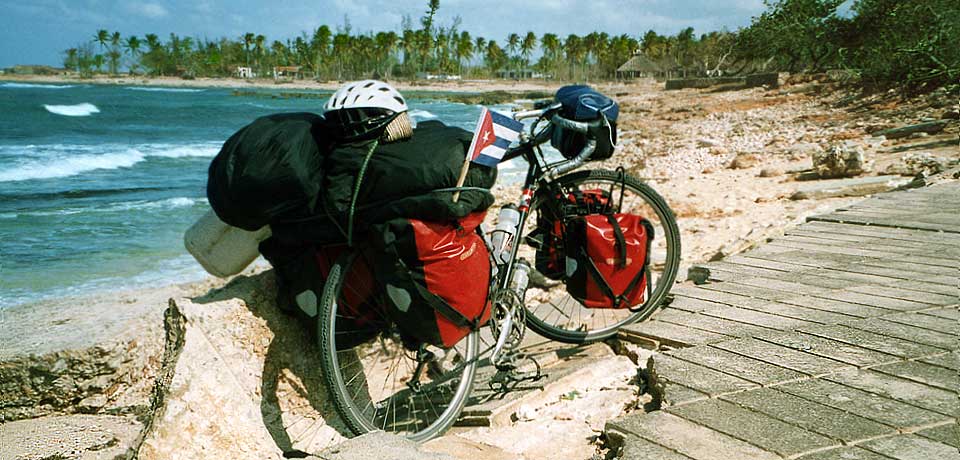

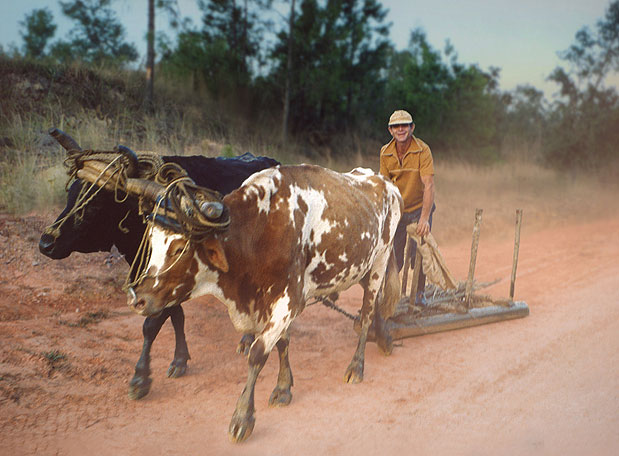
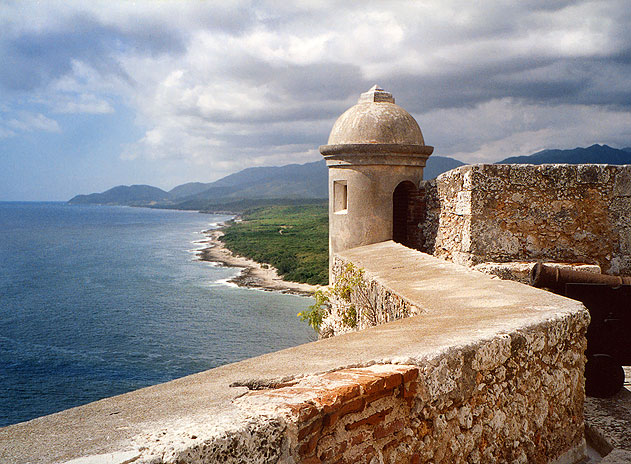
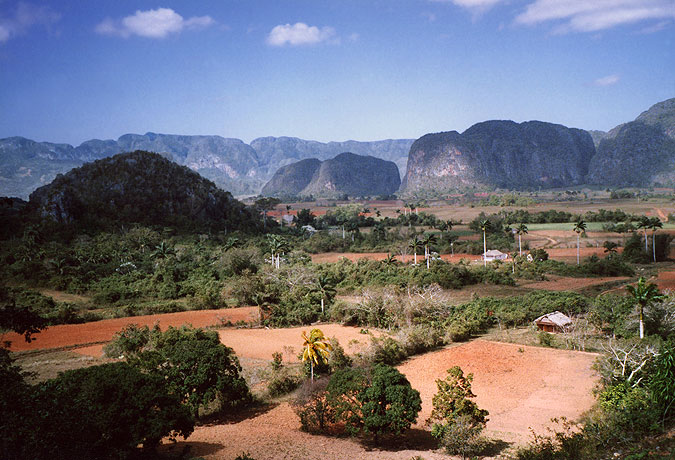
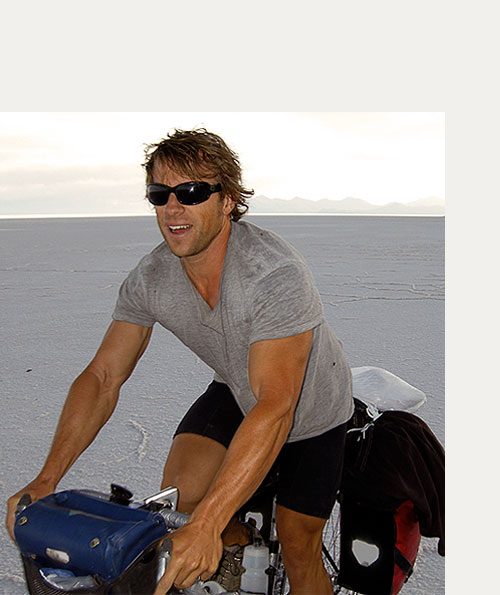
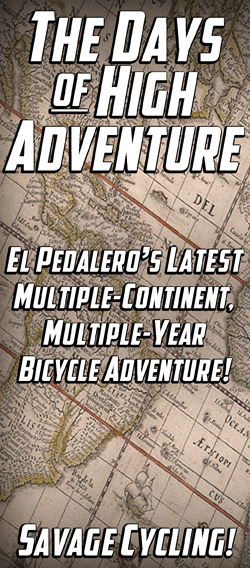
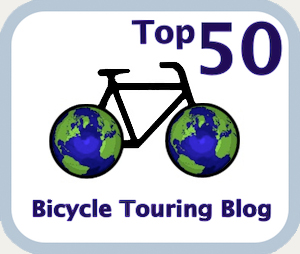
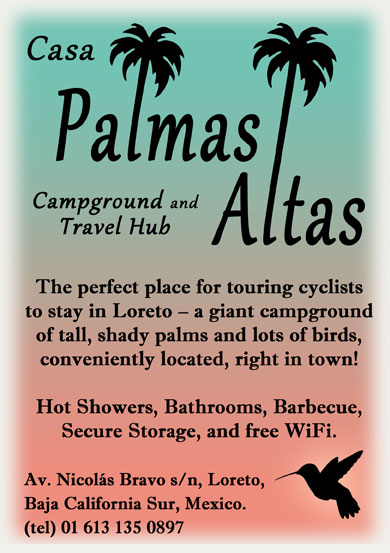
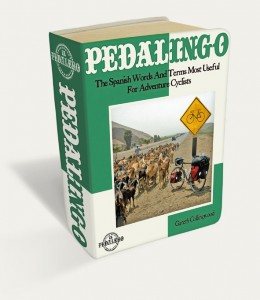
Hi Gareth – what are your thoughts on solo cycling for women in cuba? I’ve done a few 3 week or so trips – and am looking for a brief winter get away (1 week ish) – and am wondering about cuba. I’ll work at recruiting a friend … but not sure!
Well, speaking as an admittedly non-solo-woman cyclist, I would say you can expect a high level of safety, but a certain level of disrespectful behaviour (cat calls, lewd gestures, inappropriate remarks, etc.).
I say this based on the anecdotes of solo female cyclists I’ve met who have toured Cuba and also from my own observations as the boyfriend of a female cyclist who, despite my obvious presence (and much to my annoyance), received several lewd behaviours. I can only suppose there would have been many more such instances had I not been there.
Having said that, I must also state that the slimeballs are in the extreme minority and most Cubans are respectful, generous people worthy of meeting.
A thick skin goes a long way when you’re on the road solo.
Best of luck with your travels!
Hi!
What do you think about a 24year old female cycling solo around Cuba? I was thinking of doing it May-August next year. Any advice is welcome! Thanks.
Charlotte
hello! thank you for the excellent post! any suggestions for a 3.5-4 week tour? I would appreciate any advice thank you!
Hi Miguel,
Thanks for the question. For that amount of time I’d pick one area to explore rahter than tackling too much of the island (it’s bigger than it looks once you’re there). Perhaps consider touring around Pinar Del Rio province. Take a tent with you to expand your options considerably and save a lot of money.
Best,
Gareth C
Gareth,
Great article, I’m toying with a 2 week trip from Holguin to Havana. I would be a solo male Brit but I do not speak a word of Spanish, do you think this would cause difficulty? I was hoping to just load up on tinned food and camp as many nights as possible. I’d be interested too hear your “must go” areas, I had in mind a loop to Guantanamo, Santiago and Sierra Maestra and then making my way to Havana depending on which ever coastline looked the best.
Thanks
Chris
Thanks, Chris. Good questions!
For two weeks, you definitely have the option of loading up on tinned food. My concerns with this approach are: (1) You’ll have a hard time finding tinned food in Cuba, (2) If you take tinned food from the UK there’s the possibility it won’t make it through with your baggage, and (3) Carrying all that extra weight will make Cuba’s already steep hills that much harder. It might be worth a try, that said. Or just take a few tins for backup.
As for possible routes, two weeks is not enough to ride more than one area. There are great spots all over the country, but if I had to choose just one area, it would be Pinar del Río and western Cuba. Your proposed route is adventurous, but it’s a little far to go unless you’re trying to cover ground fast. I prefer to tour slowly and take days off here and there. As for better coastline, I’d say the Sierra Maestra coastline. Guantanamo was my least favourite area to tour; not awful, but not as beautiful or interesting as the west.
I’d try to learn some basic (survival) Spanish if you can. You will find people who speak English, but with older people in the campo (where you’re likely to be camping much of the time) you’ll need some Spanish.
Hope that helps a bit. Mucha suerte with everything!
Gareth
Great blog! Can you please recommend a 7 day route or a book/blog with this information? Yeah, I know, just 7 days ! That’s life at the moment. Hope you can help. PS. I love wild camping.
Hmm, a seven day route would depend on lots of things – speed, distances, road conditions, camping opportunities. Lots of unpredictable variables in Cuba!
Perhaps a Pinar del Río loop. Or Sierra Maestra out-and-back from Santiago de Cuba. Those would be my top choices for one week.
Hi Gareth. My husband and I are going on a 4 week bicycle tour of Cuba and hope to camp most of the time, so we are taking full camping gear. We are wondering about petrol for our stove. Is it easy to buy or is it rationed? I particularly like to cook our own food (and I hope we can get some, from some of the articles I have read!!) as I am vegetarian.
I look forward to receiving any help you can give me. Susan (England)
Hi Susan,
Good questions. Things may have changed since I was last in Cuba, but here are my thoughts…
If your stove works with petrol from the service station, then yes, you will find fuel. It may clog the stove a little faster than you’re used to, but it’s worth a try. I never bothered to use my camp stove in Cuba. What food I found was prepared by Cubans at their homes in exchange for a few pesos.
If you plan on staying vegetarian in Cuba you will eat rice and beans, mostly. If you’re willing to consume eggs, at least, you’ll extend your options and stay healthy. Depending what time of year you travel, you may find mangoes and other fruits available for the picking. The ration “stores” are not for foreigners, but if you’re patient you’ll be able to scrounge some food; mostly bread.
Honestly, the food situation in Cuba (the “real” Cuba as opposed to the “tourist” Cuba) is certainly lacking. Be flexible and optimistic and don’t be shy about asking for help (and for food).
Let us know how the trip goes!
Suerte,
Gareth
Thanks for replying Gareth. It’s great to find someone who is willing to share his knowledge and to help. When Mike and I camp we always wild camp but like to be well hidden. In the few articles I have read where people camp in Cuba it seems to be on the beach, under bridges!!! and generally near casas, towns etc. What are the chances of finding very secluded hidden spots to pitch a tent? Also, little biting flies just love me and I have again read that the beaches at sunrise and sunset are a torment with them. Do you know if there is a season? We are going in February.
Our provisional trip plan is to spend a couple of days in Havana then bus to Playa Larga and cycle to Cienfuegos & Trinidad, then bus to Bayamo and cycle the coast to Santiago de Cuba. Another bus back to Havana, stopping for a day in Carmaguey (primarily because we won’t be able to handle the long journey in one go). From Havana we will cycle to Terrazas and Vinales and do the Caya Jutias circuit and then bus back to Havana. That will probably give us 4 days to play with at any one of the regions we visit, probably cycling back to Havana from Vinales.
We wouldn’t usually contemplate taking our bicycles on buses but this seems to be the only way to visit the three regions we want to cycle in. Also at 70 & 75 we are not up to cycling the long distances of our relative youth (I got on a bicycle for the first time at 50 years, did a warm-up trip in the Lofoten Islands of Norway then cycled through Alaska and just fell in love with cycle touring.
Any comments or suggestions on the camping aspect and our route would be very much appreciated.
I know the time it takes to reply to everyone as you do, and salute you for it.
Many thanks. Susan.
Hi Gareth, thanks for writing the posts about Cuba, my wife and I are heading there in a few weeks and have enjoyed reading them more than once. Our research (internet forums, friends, and one book) has led us to believe that taking our tent, mats, and stove is probably going to be a waste of weight and space. This is our first proper cycle touring trip (we have 4 weeks) and so we realise we should keep things simple and light, however we love camping and it would be a shame to get to Cuba and see lovely camping spots and not have our gear with us. We’ve read about how hard food can be to source and how hot it will be so we’re aware that it’s not the easiest place to camp.
So in summary, almost every other source – other than your article above(!) – seems to advise against camping so given our amateur touring status I was wondering what would your advise might be? Thanks in advance…
Hi Rupert!
Thanks for stopping by El Pedalero!
It’s funny; I get this question a lot. Perhaps it’s because Cuba has done a good job of advertising its casas particulares program. Or perhaps it’s the guidebooks that mention only the lack of tourist campground facilities, which is true, but that’s not where I’d want to camp anyway.
When I think of camping in Cuba (or anywhere else for that matter) I’m thinking of wild camping. If you limit yourself to casas particulares or the almost non-existent tourist campgrounds, you’ll have a less-adventurous (and in my opinion, less-interesting) trip. I’m curious to know why your sources advise against camping. I can only assume they haven’t really given it a go the way I have. I’ve spent several months in Cuba, cycling the entire island and camping in every province. I’ve also stayed in the odd casa (both official and unofficial) but only for fun, not because I had to.
If you truly love camping (and I do too), I think it would be a shame to miss the chance to set up your tent on a beach along the Sierra Maestra and sleep to the sound of waves rolling in, or gaze up at the stars through your mosquito netting! Even if you’re new to touring, it’s not hard to figure out: find a nice, quiet spot; peg down; and relax!
Suerte!
good article–wish it was longer. you hit the nail on the head with much of your commentary. we spent 3 weeks traveling central to western cuba last year. fell in love with the place. i admire your adventurous spirit. it allows you to experience the world and not just read or hear about it. i have a contact in havana who organizes all the bike tours and races throughout the country. he’s from ontario, married to a cuban woman and does his business in canada.
now i have to read your other articles. well done, gareth.
bevin
Thanks, Bevin!
I know what you mean about western Cuba. I circled the whole country, but it was the west, especially Pinar del Río, that really impressed me with its landscapes and mysterious hidden corners.
Fantastic to hear from you!
Here is another Cuban article you might find amusing.
Gareth